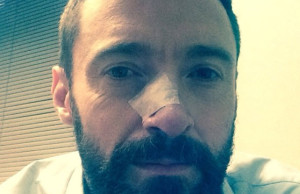Lisa Gastineau undergoes reconstructive surgery after skin cancer scare

Reality star Lisa Gastineau, has undergone reconstructive surgery on her nose to improve the scar left from the removal of basal cell skin cancer in October. The co-star of the E! reality show The Gastineau Girls, is the mother of model, socialite and co-star Brittny Gastineau. Gastineau told People magazine that the surgery,which removed part of her nostril,”left me with an ugly scar and a weird pull across my septum. I was feeling a bit like Phantom of the Opera – really ugly and disfigured.”
- Epidermis: The epidermis is the top layer of the skin. It is mostly made of flat cells called squamous cells. Under the squamous cells in the deepest part of the epidermis are round cells called basal cells. Cells called melanocytes make the pigment (color) found in skin and are located in the lower part of the epidermis
- Dermis: The dermis lies under the epidermis and contains blood vessels, lymph vessels, and glands. Some of these glands make sweat, which helps cool the body. Other glands make sebum, an oily substance that helps keep the skin from drying out. Sweat and sebum reach the surface of the skin through tiny openings called pores.
Basal cell carcinoma (BCC) is the most common form of skin cancer, affecting approximately one million Americans each year. In fact, it is the most common of all cancers. More than one out of every three new cancers are skin cancers, and the vast majority are basal cell carcinomas.
Basal cell carcinoma starts in the epidermis. It grows slowly and is painless. The majority of these cancers occur on areas of skin that are regularly exposed to sunlight or other ultraviolet radiation. UV radiation comes from the sun, sunlamps, tanning beds, or tanning booths. A person’s risk of skin cancer is related to lifetime exposure to UV radiation. Basal cell skin cancer used to be more common in people over age 40, but is now often diagnosed in younger people, and the sun can damage the skin from an early age.
The risk for basal cell skin cancer is higher if you have fair skin, blue or green eyes, blond or red hair, or a history of overexposure to x-rays or other forms of radiation. Basal cell carcinoma occurs most commonly on parts of the body exposed to the sun- especially the face, ears, neck, scalp, shoulders, and back.
Basal cell skin cancer almost never spreads to distant sites. But, if left untreated, it may grow into surrounding areas and nearby tissues and bone.
Signs and Symptoms of Basal Cell Carcinoma:
 Basal cell carcinoma may look only slightly different than normal skin. The cancer may appear as skin bump or growth that is pearly or waxy, and white, light pink, flesh-colored or brown in color. In some cases the skin may be just slightly raised or even flat.
Basal cell carcinoma may look only slightly different than normal skin. The cancer may appear as skin bump or growth that is pearly or waxy, and white, light pink, flesh-colored or brown in color. In some cases the skin may be just slightly raised or even flat.
Other signs include:
* A skin sore that bleeds easily
* A sore that does not heal
* Oozing or crusting spots in a sore
* Appearance of a scar-like sore without having injured the area
* Irregular blood vessels in or around the spot
* A sore with a depressed (sunken) area in the middle
Treatment consists of removing the tumor. Obviously, the earlier the better, before the tumor invades other local tissues or bone.
For more information:
| Resounding Health(tm) Basal Cell Carcinoma |



























1 Comment